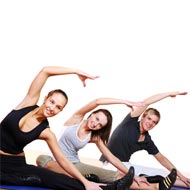- Aromatherapy (36)
- Benefits of Yoga (282)
- Home Remedies (1087)
- massage therapy (9)
- Preventive Therapy (135)
- Running (41)
- Skin Care (15)
- Stress Relief (25)
- Stretching (5)
- walking (33)
- Womens Health (14)
- Yoga Benefits for Pregnant Women (16)
- Yoga Benefits for Students (3)
- Yoga for Children (11)
- Yoga for Holistic Living (37)
- Yoga for Midlife Crisis (3)
- Yoga for Senior Citizens (2)
- Yoga for the Workplace (1)
- Yoga Health Tips (185)
- Yoga Practice during Menstruation (5)
Sequential Yoga Workouts

Yoga encompasses yoga poses or asanas, controlled breathing technique or pranayama and meditation. Practice of these three facets of yoga conditions the body and mind.
Normally, the following sequence is followed for practicing yoga poses :
- Standing Postures
- Sitting Postures
- Lying Down Postures
- Inverted Postures
However, the meditative yoga poses should precede the physical postures. Thus always begin practice of yoga with either Lotus Pose (Padmasana) or Adept Pose (Siddhasana) or Comfortable pose (Sukhasana). Any of these meditative postures will calm your nerves and prepare you for practicing yoga in a serene state of mind.
Sun Salutation is one complete yoga exercise consisting of 12 poses which is normally performed as a preliminary to the practice of yoga poses.
Thereafter do standing poses first, followed by sitting, lying and inverted postures, backward bends, twists and forward bends. This should be followed by 5 to 10 minutes of The Corpse Pose or Shavasana.
Easy Yoga poses must precede the moderately difficult ones which again must precede the difficult ones. Moving from easy to moderate to difficult ones should be done gradually.
Group the postures according to their physical benefits and ease of performance. Then select the yoga poses sequentially i.e. standing, sitting, lying, inverted, bends, twists and stick to the selected postures for a few weeks. You will realize the benefits from these yoga poses after 3 months of regular practice only.
It is also important to practice each yoga pose correctly and in proper sequence. You need to perfect the performance of the yoga poses. Therefore, learning yoga under the proper guidance of a yoga teacher is of utmost importance.
You should practice yoga poses which will work out all parts and organs of your body. Spinal stretching is very important and includes upward or vertical stretch, sideways or lateral stretch to the right and left and backward and forward stretch.
Bhujangasana (The Cobra Pose) is excellent for vertebrae.
Sarvangasana (The Shoulder-Stand Pose)
Halasana (The Plough Pose)
Paschimottanasana (The Posterior Stretch)
Yoga poses which are performed on both sides of the body should not be performed on one side. In all postures where right or left side of the body is stretched, bent or twisted, the opposite side must also be similarly done to balance the effect.
It is not possible to do multitude of postures at one go. Select a few yoga postures for daily practice, followed by rhythmic breathing or Pranayam which should include Bhastrika (The Bellows Breath), Kapalbhati (The Cleansing Breath) and Anulom-Vilom (Alternate nostril breathing). This will keep you physically fit and mentally poised.
- RSS Feeds -
- All posts
- All comments
- Treadmill running Treadmills are excellent devices for training. Especially during winters when...
- Yoga with Jillian Michaels: Yoga to melt those extra pounds Personal trainer and reality show personality, Jillian Michael’s is bes...
- Treadmill Workouts Treadmill workouts or elliptical workouts include exercises such as runni...
- Music While Walking The benefits that exercises offer are well known to everyone. But the advanta...